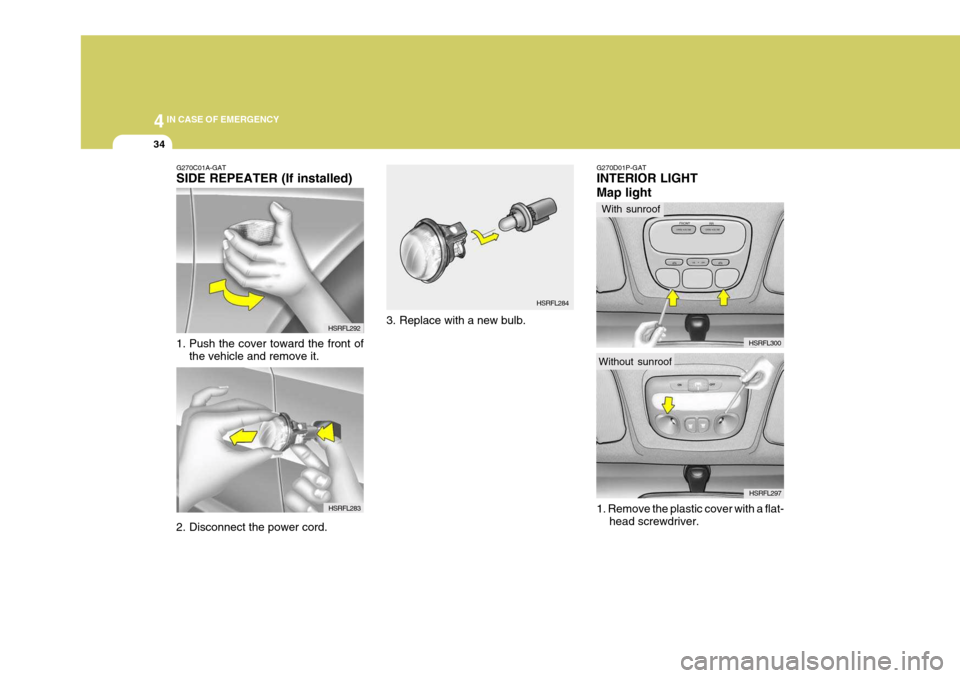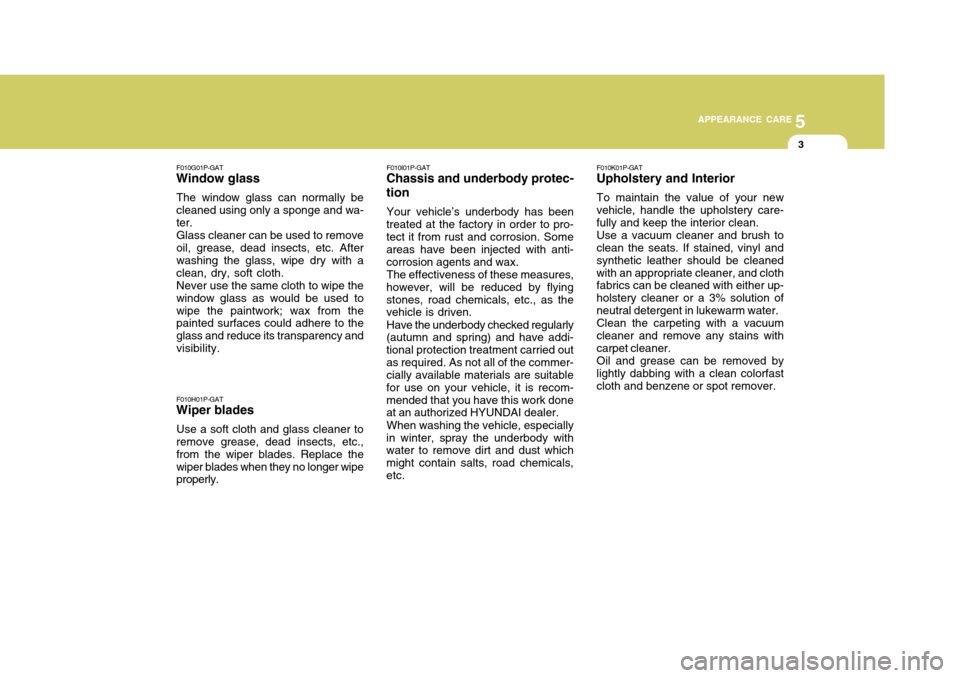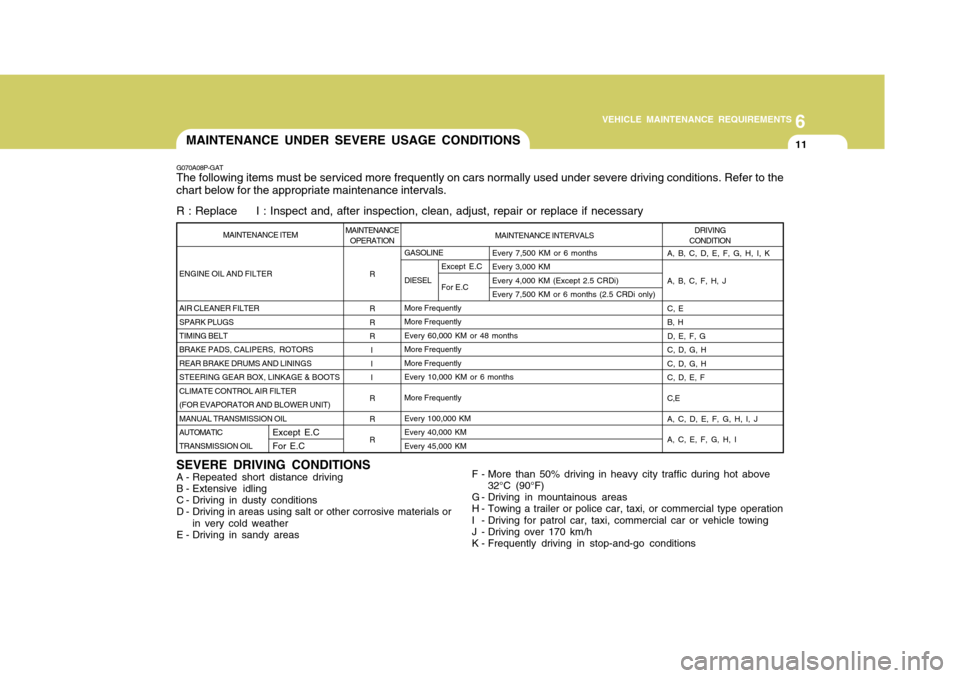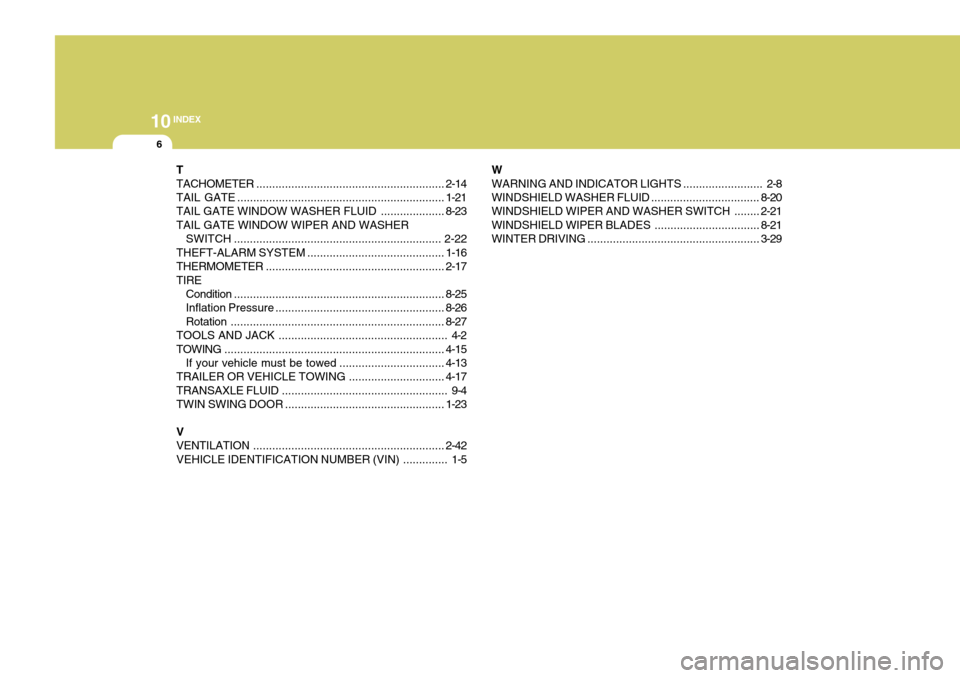2007 Hyundai H-1 (Grand Starex) tow
[x] Cancel search: towPage 197 of 284

4
CORROSION PREVENTION AND APPEARANCE CARE
21
4
IN CASE OF EMERGENCY
21BLEEDING THE FUEL SYSTEM
CAUTION:
If overheating should occur when towing, (temperature gauge reads near red zone), taking the followingaction may reduce or eliminate the problem.
1. Turn off the air conditioner.
2. Reduce highway speed.
3. Select a lower gear when going uphill.
4. While in stop and go traffic, place
the gear selection in park or neu-tral and idle the engine at a higher speed.
! E090A01P-GAT (Diesel Motor) The fuel system should be bled to remove air as described in the illustra- tion if the fuel supply is exhaustedduring travel, when the fuel filter is replaced, or if the vehicle is not used for a long time.
1. Loosen the air plug at the top of the
fuel filter. E090A01P
13.Avoid holding the brake pedal down
too long or too frequently. This could cause the brakes to overheat, re- sulting in reduced braking efficiency.
14.When going down a hill, shift into a
lower gear and use the engine brak-ing effect. When ascending a long grade, downshift the transmissionto a lower gear and reduce speed to reduce chances of engine over- loading and/or overheating.
15.If you have to stop while going uphill, do not hold the vehicle inplace by pressing on the accelera-tor. This can cause the automatic transmission to overheat. Use the parking brake or footbrake.
NOTE: When towing, check transmission fluid more frequently.
Page 204 of 284

44IN CASE OF EMERGENCY
28
If you suspect a blown fuse, follow this procedure:
1. Turn off the ignition and all other
switches.
2. Open the fuse box and examine each fuse. Remove each fuse by pulling it toward you (a small "fusepuller" tool is contained in the fuse box to simplify this operation).
3. Be sure to check all other fuses even if you find one that appears tohave burned out.
HSR40224. Replace the blown fuse by pressing
a new fuse of the same rating into place. The fuse should be a snug fit. If it is not, have the fuse clip repaired or replaced by a Hyundai dealer. Ifyou do not have a spare fuse, you may be able to borrow a fuse of the same or lower rating from an acces-sory you can temporarily get along without (the radio or cigarette light- er, for example). Always rememberto replace the borrowed fuse.
G200B02A
Good
Burned out
!
CAUTION:
A burned-out fuse indicates that there is a problem in the electrical circuit. If you replace a fuse and it blows as soon as the accessory isturned on, the problem is serious and should be referred to a Hyun- dai dealer for diagnosis and repair.Never replace a fuse with anything except a fuse with the same or a lower amperage rating. A highercapacity fuse could cause damage and create a fire hazard. NOTE: See page 4-40 for the fuse panel descriptions.
Page 210 of 284

44IN CASE OF EMERGENCY
34
HSRFL283
G270C01A-GAT SIDE REPEATER (If installed)
1. Push the cover toward the front of
the vehicle and remove it. HSRFL292
3. Replace with a new bulb. HSRFL284
2. Disconnect the power cord. G270D01P-GAT INTERIOR LIGHT Map light 1. Remove the plastic cover with a flat-
head screwdriver. HSRFL300
HSRFL297
With sunroof
Without sunroof
Page 224 of 284

5
APPEARANCE CARE
3
F010G01P-GAT
Window glass
The window glass can normally be cleaned using only a sponge and wa- ter. Glass cleaner can be used to remove oil, grease, dead insects, etc. After washing the glass, wipe dry with aclean, dry, soft cloth.Never use the same cloth to wipe thewindow glass as would be used towipe the paintwork; wax from the painted surfaces could adhere to the glass and reduce its transparency andvisibility. F010H01P-GAT
Wiper blades
Use a soft cloth and glass cleaner to remove grease, dead insects, etc., from the wiper blades. Replace thewiper blades when they no longer wipe properly. F010I01P-GAT
Chassis and underbody protec- tion
Your vehicle’s underbody has been
treated at the factory in order to pro- tect it from rust and corrosion. Some areas have been injected with anti-corrosion agents and wax. The effectiveness of these measures,
however, will be reduced by flyingstones, road chemicals, etc., as the vehicle is driven.
Have the underbody checked regularly
(autumn and spring) and have addi- tional protection treatment carried outas required. As not all of the commer- cially available materials are suitable for use on your vehicle, it is recom-mended that you have this work done at an authorized HYUNDAI dealer.
When washing the vehicle, especially
in winter, spray the underbody withwater to remove dirt and dust which might contain salts, road chemicals,etc. F010K01P-GAT Upholstery and Interior To maintain the value of your new vehicle, handle the upholstery care- fully and keep the interior clean. Use a vacuum cleaner and brush to clean the seats. If stained, vinyl and synthetic leather should be cleanedwith an appropriate cleaner, and cloth fabrics can be cleaned with either up- holstery cleaner or a 3% solution ofneutral detergent in lukewarm water.Clean the carpeting with a vacuumcleaner and remove any stains withcarpet cleaner.Oil and grease can be removed bylightly dabbing with a clean colorfast cloth and benzene or spot remover.
Page 226 of 284

5
APPEARANCE CARE
5
F010O01P-GAT
Load weight and driving speed
Remove any luggage, etc., which is
not necessary from the vehicle. The load weight placed on the roof or towed in a trailer also should not be exces-sive. Correctly adjusting the air pressure of
the tires before driving under maxi- mum load weight conditions and be- fore driving long distances is espe-cially important. F010P01P-GAT
Tire replacement
Tires which do not meet the size
specifications must not be used. Re- placement of the tires must be made as a set of the two front tires, the tworear tires, or all four tires. A mixture of bias-ply tires and radial
tires must not be used. Consult an authorized HYUNDAI dealer regarding tire replacement.
F010Q01P-GAT
Kerb parking
If the tires strike a kerb or concrete
parking barrier, they could be dam-aged, and this damage could become a source of extreme danger when the vehicle is subsequently driven at highspeed. If the vehicle is to be driven or onto a kerb or any other such barrier, it should be driven slowly and at anappropriate angle to the kerb or barrier. F010R01P-GAT
Tire care
For driving safely, and in order toobtain the maximum useful life of thetires, the following points should be observed. For information concerning inspection, air pressure, and rotationof the tires, refer to the part which deals with wheels in the section of this manual entitled "Consumer Informa-tion". F010S01P-GAT Tire air pressure The air pressure of the tires must always be maintained in accordance with the specifications, and should be measured when the tires are cool.If any changes in driving conditions(speed and/or load weight) occur, theair pressure of the tires must meet the specifications which apply to the new driving conditions. If the vehicle isgoing to be driven under varying load weight, etc., the air pressure must be adjusted in order to meet the highestspecifications of the conditions under which the vehicle is driven (high speeds and maximum load weight). F010T01P-GAT Tire storage Storage of the tires should be in a dark, well-ventilated place.Tires not mounted on rims should bestored vertically. Be sure that the tires are not in contact with fuel, oil grease, etc.
Page 237 of 284

6
VEHICLE MAINTENANCE REQUIREMENTS
11
GASOLINE DIESELMore Frequently More Frequently Every 60,000 KM or 48 monthsMore FrequentlyMore FrequentlyEvery 10,000 KM or 6 months More Frequently Every 100,000 KM Every 40,000 KMEvery 45,000 KM Every 7,500 KM or 6 monthsEvery 3,000 KMEvery 4,000 KM (Except 2.5 CRDi)Every 7,500 KM or 6 months (2.5 CRDi only)
ENGINE OIL AND FILTER AIR CLEANER FILTER SPARK PLUGSTIMING BELT BRAKE PADS, CALIPERS, ROTORS REAR BRAKE DRUMS AND LININGSSTEERING GEAR BOX, LINKAGE & BOOTSCLIMATE CONTROL AIR FILTER(FOR EVAPORATOR AND BLOWER UNIT)MANUAL TRANSMISSION OIL AUTOMATIC TRANSMISSION OIL
G070A08P-GAT The following items must be serviced more frequently on cars normally used under severe driving conditions. Refer to the chart below for the appropriate maintenance intervals. R : Replace I : Inspect and, after inspection, clean, adjust, repair or replace if necessary
R R RR
I I I
R R R
SEVERE DRIVING CONDITIONS A - Repeated short distance driving
B - Extensive idling
C - Driving in dusty conditions
D - Driving in areas using salt or other corrosive materials or
in very cold weather
E - Driving in sandy areas
A, B, C, D, E, F, G, H, I, K A, B, C, F, H, J C, E B, HD, E, F, GC, D, G, HC, D, G, H C, D, E, F C,EA, C, D, E, F, G, H, I, J A, C, E, F, G, H, I DRIVING
CONDITION
MAINTENANCE INTERVALS
MAINTENANCE
OPERATION
MAINTENANCE ITEM
F - More than 50% driving in heavy city traffic during hot above32°C (90°F)
G - Driving in mountainous areas
H - Towing a trailer or police car, taxi, or commercial type operation
I - Driving for patrol car, taxi, commercial car or vehicle towing
J - Driving over 170 km/h
K - Frequently driving in stop-and-go conditions
MAINTENANCE UNDER SEVERE USAGE CONDITIONS
Except E.C For E.C
Except E.C For E.C
Page 282 of 284

10INDEX
6
T TACHOMETER ........................................................... 2-14
TAIL GATE ................................................................. 1-21
TAIL GATE WINDOW WASHER FLUID .................... 8-23
TAIL GATE WINDOW WIPER AND WASHER SWITCH ................................................................. 2-22
THEFT-ALARM SYSTEM ... ........................................1-16
THERMOMETER ........................................................ 2-17
TIRE Condition .................................................................. 8-25
Inflation Pressure ..................................................... 8-26
Rotation ................................................................... 8-27
TOOLS AND JACK ..................................................... 4-2
TOWING ..................................................................... 4-15
If your vehicle must be towed ................................. 4-13
TRAILER OR VEHICLE TOWIN G ..............................4-17
TRANSAXLE FLUID .................................................... 9-4
TWIN SWING DOOR .................................................. 1-23
V VENTILATION ............................................................ 2-42
VEHICLE IDENTIFICATION NUMBER (VIN) .............. 1-5W
WARNING AND INDICATOR LIGHTS
......................... 2-8
WINDSHIELD WASHER FLUID ..................................8-20
WINDSHIELD WIPER AND WASHER SWITCH ........2-21
WINDSHIELD WIPER BLADES ................................. 8-21
WINTER DRIVING ...................................................... 3-29